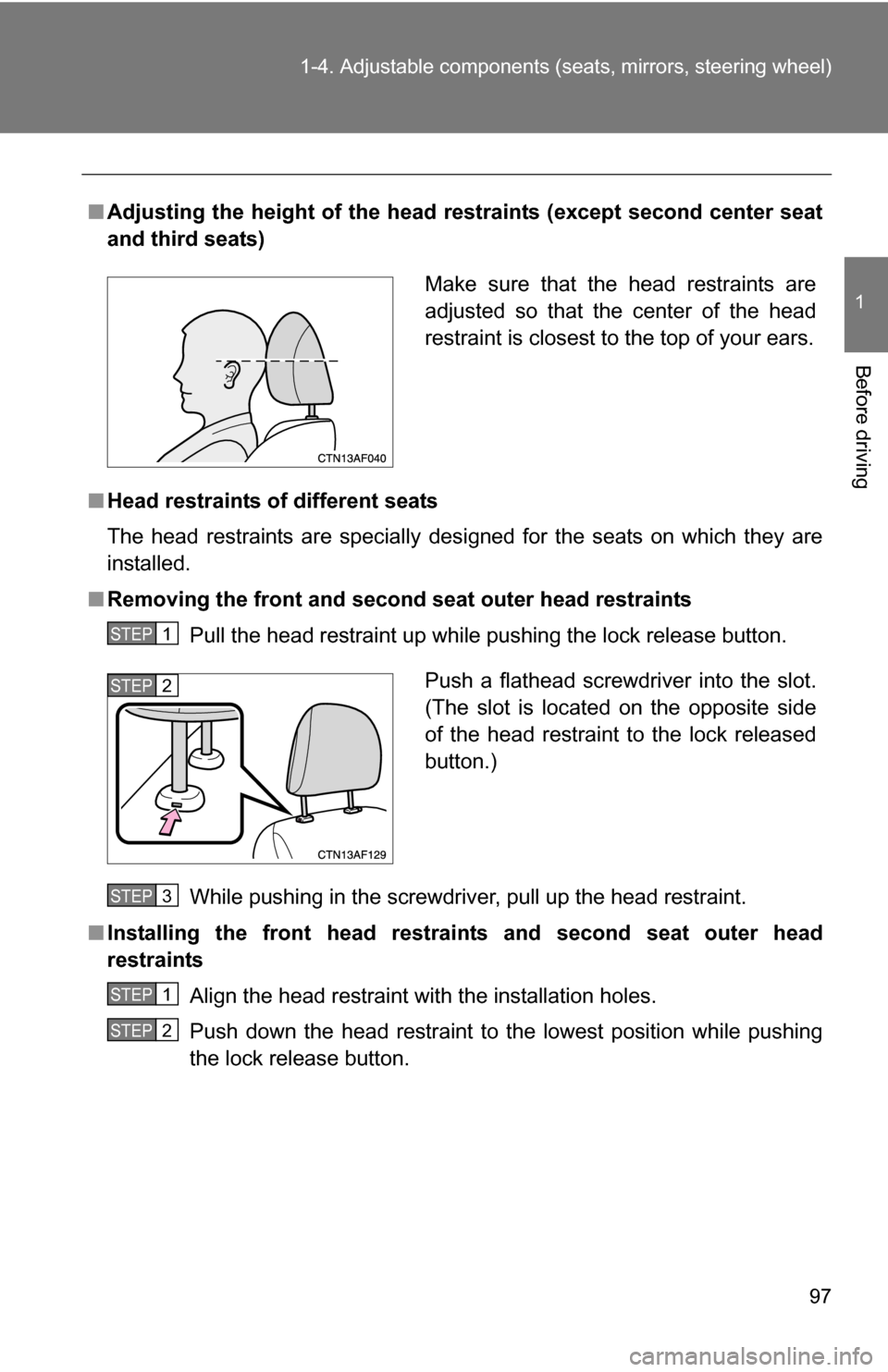Page 84 of 580
84
1-4. Adjustable components (seats, mirrors, steering wheel)
Front seats
Manual seat
Seat position adjustment lever
Seatback angle adjustment lever
Vertical height adjustment lever (driver’s side only)
Seat cushion (front) angle adjustment knob (driver’s side only)
Pull up the lever until the lock is completely released.
Page 85 of 580
85
1-4. Adjustable components (s
eats, mirrors, steering wheel)
1
Before driving
Active head restraints
When the occupant’s back
presses against the seatback
during a rear-end collision, the
head restraint moves slightly for-
ward to help reduce the risk of
whiplash on the seat occupant.
Power seat
Seat position adjustment switch
Seatback angle adjustment switch
Seat cushion (front) angle adjustment switch (driver’s side only)
Vertical height adjustment switch (driver’s side only)
Driver’s seat leg support adjustment switch (if equipped)
Seat lumbar support adjustment switch (driver’s side only)
Page 97 of 580

97
1-4. Adjustable components (s
eats, mirrors, steering wheel)
1
Before driving
■Adjusting the height of the head restraints (except second center seat
and third seats)
■ Head restraints of different seats
The head restraints are specially designed for the seats on which they are
installed.
■ Removing the front and second seat outer head restraints
Pull the head restraint up while pushing the lock release button.
While pushing in the screwdriver, pull up the head restraint.
■ Installing the front head rest raints and second seat outer head
restraints
Align the head restraint with the installation holes.
Push down the head restraint to the lowest position while pushing
the lock release button.
Make sure that the head restraints are
adjusted so that the center of the head
restraint is closest to the top of your ears.
STEP1
Push a flathead screwdriver into the slot.
(The slot is located on the opposite side
of the head restraint to the lock released
button.)STEP2
STEP3
STEP1
STEP2
Page 100 of 580
100 1-4. Adjustable components (seats, mirrors, steering wheel)
Seat belt pretensioners (front seats)
The pretensioner helps the seat
belt to quickly restrain the occu-
pant by retracting the seat belt
when the vehicle is subjected to
certain types of severe frontal
collision or a vehicle rollover.
The pretensioner may not acti-
vate in the event of a minor frontal
impact, a side impact or a rear
impact.
■Adjusting the height of the belt (front seats)
Down
Up
Move the height adjuster up
and down as needed until you
hear a click.
Page 220 of 580
220
2-5. Driving information
Utility vehicle precautions
Utility vehicle feature● Specific design characteristics give it a higher center of gravity
than ordinary passenger cars. This vehicle design feature causes
this type of vehicle to be more likel y to rollover. And, utility vehicles
have a significantly higher rollover rate than other types of vehi-
cles.
● It is not designed for cornering at the same speeds as ordinary
passenger cars any more than lo w-slung sports cars designed to
perform satisfactorily under off-road conditions. Therefore, sharp
turns at excessive speeds may cause rollover.
This vehicle belongs to the utility vehicle class, which has higher
ground clearance and narrower tread in relation to the height of its
center of gravity.
Page 530 of 580
530
6-1. Specifications
Maintenance data (fuel, oil level, etc.)
Dimensions and weights
Overall length188.4 in. (4785 mm)
Overall width75.2 in. (1910 mm)
Overall height Without roof rails
68.1 in. (1730 mm)
With roof rails
69.3 in. (1760 mm)
Wheelbase
109.8 in. (2790 mm)
Front tread 64.0 in. (1625 mm)
Rear tread64.0 in. (1625 mm)
Vehicle capacity weight
(Occupant + luggage) 1200 lb. (540 kg)
Towing capacity
(Trailer weight + cargo)3500 lb. (1500 kg)
Page 550 of 580
550 6-1. Specifications
Tire size■ Typical tire size information
The illustration indicates typical
tire size.
Tire use
(P = Passenger car,
T = Temporary use)
Section width (millimeters)
Aspect ratio
(tire height to section width)
Tire construction code
(R = Radial, D = Diagonal)
Wheel diameter (inches)
Load index (2 or 3 digits)
Speed symbol
(alphabet with one letter)
■ Tire dimensions
Section width
Tire height
Wheel diameter